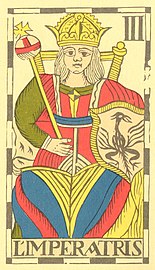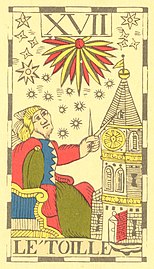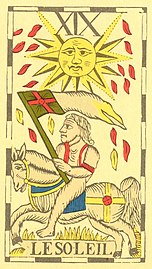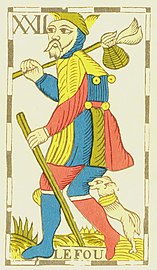
Tarot is a pack of playing cards, used from at least the mid-15th century in various parts of Europe to play card games such as Tarocchini. From their Italian roots, tarot-playing cards spread to most of Europe, evolving into a family of games that includes German Grosstarok and modern games such as French Tarot and Austrian Königrufen. In the late 18th century French occultists made elaborate, but unsubstantiated, claims about their history and meaning, leading to the emergence of custom decks for use in divination via tarot card reading and cartomancy. Thus, there are two distinct types of tarot packs in circulation: those used for card games and those used for divination. However, some older patterns, such as the Tarot de Marseille, originally intended for playing card games, are occasionally used for cartomancy.

The Major Arcana are the named or numbered cards in a cartomantic tarot pack, the name being originally given by occultists to the trump cards of a normal tarot pack used for playing card games. There are usually 22 such cards in a standard 78-card pack, typically numbered from 0 to 21. The name is not used by tarot card game players.

The High Priestess (II) is the second Major Arcana card in cartomantic Tarot decks. It is based on the 2nd trump of Tarot card packs. In the first Tarot pack with inscriptions, the 18th-century woodcut Tarot de Marseilles, this figure is crowned with the Papal tiara and labelled La Papesse, the Popess, a possible reference to the legend of Pope Joan.
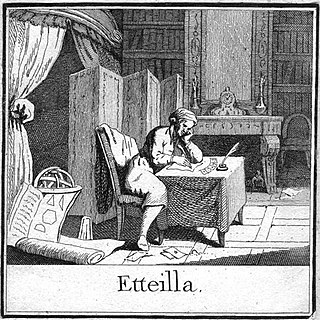
"Etteilla", the pseudonym of Jean-Baptiste Alliette, was the French occultist and tarot-researcher, who was the first to develop an interpretation concept for the tarot cards and made a significant contribution to the esoteric development of the tarot cards to a wide audience, and therefore the first professional tarot occultist known to history who made his living by card divination. Etteilla also influenced the French divination professional Marie Anne Lenormand. In the years 1783–1785 Etteilla published his work Manière de se récréer avec le jeu de cartes nommées tarots, which is still considered the standard reference work of Tarot cartomancy. Etteilla published his ideas of the correspondences between the tarot, astrology, and the four classical elements and four humors, and in 1789 he published his own tarot deck, which, however, differed significantly from the classic tarots such as the Tarot de Marseille in terms of structure and card designations.
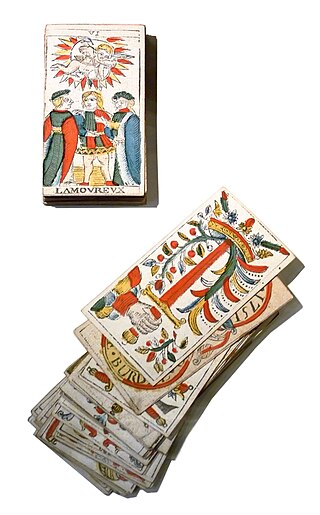
The Tarot of Marseilles is a standard pattern of Italian-suited tarot pack with 78 cards that was very popular in France in the 17th and 18th centuries for playing tarot card games and is still produced today. It was probably created in Milan before spreading to much of France, Switzerland and Northern Italy. The name is sometimes spelt Tarot of Marseille, but the name recommended by the International Playing-Card Society is Tarot de Marseille, although it accepts the two English names as alternatives. It was the pack which led to the occult use of tarot cards, although today dedicated decks are produced for this purpose.
Minchiate is an early 16th-century card game, originating in Florence, Italy. It is no longer widely played. Minchiate can also refer to the special deck of 97 playing cards used in the game. The deck is closely related to the tarot cards, but contains an expanded suit of trumps. The game was similar to but more complex than tarocchi. The minchiate represents a Florentine variant on the original game.

Trionfi are 15th-century Italian playing card trumps with allegorical content related to those used in tarocchi games. The general English expression "trump card" and the German "trumpfen" have developed from the Italian "Trionfi". Most cards feature the personification of a place or abstraction.

A trump is a playing card which is elevated above its usual rank in trick-taking games. Typically an entire suit is nominated as a trump suit; these cards then outrank all cards of plain (non-trump) suits. In other contexts the terms trump card or to trump refers to any sort of action, authority or policy which automatically prevails over all others.

Troggu is a member of the tarot family of card games. Synonyms for the game's name are: Trogga, Tappu and Tappä. It is played in the area of Visp, Switzerland, in Upper Wallis, especially in St. Niklaus and Grächen. After Troccas, it is the second most played tarot card game in Switzerland.

Tarot card reading is a form of cartomancy whereby practitioners use tarot cards to purportedly gain insight into the past, present or future. They formulate a question, then draw cards to interpret them for this end. A traditional tarot deck consists of 78 cards, which can be split into two groups, the Major Arcana and Minor Arcana. French-suited playing cards can also be used; as can any card system with suits assigned to identifiable elements.
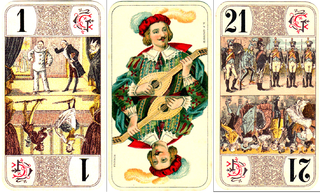
The Bourgeois Tarot deck is a mid-19th century pattern of tarot cards of German origin that is used for playing card games in western Europe and Canada. It is not designed for divinatory purposes. This deck is most commonly found in France, Belgian Wallonia, Swiss Romandy and Canadian Québec for playing French Tarot; in southwest Germany for playing Cego and Dreierles; and in Denmark for Danish Tarok.
The Tarocco Piemontese is a type of tarot deck of Italian origin. It is the most common tarot playing set in northern Italy, much more common than the Tarocco Bolognese. The most popular Piedmontese tarot games are Scarto, Mitigati, Chiamare il Re, and Partita which are played in Pinerolo and Turin. This deck is considered part of Piedmontese culture and appeared in the 2006 Winter Olympics closing ceremony held in Turin. As this was the standard tarot pack of the Kingdom of Sardinia, it was also formerly used in Savoy and Nice before their annexation by France. Additionally, it was used as an alternative to the Tarocco Siciliano in Calatafimi-Segesta, Sicily. Outside of Italy, it is used by a small number of players in Ticino, Switzerland and was used by Italian Argentines.

Animal Tarot is a genre of tarot decks used for playing card games that were most commonly found in northern Europe, from Belgium to Russia, only one of which has survived: the Adler Cego pattern in south Germany. A theme of animals, real and/or fantastic, replaces the traditional trump scenes found in the Italian-suited tarot packs such as the Tarot of Besançon. The Sküs plays a musical instrument while the Pagat is represented by Hans Wurst, a carnival stock character who carries his sausage, drink, slap stick, or hat. They constitute the first generation of French-suited tarot patterns. Prior to their introduction, tarot card games had been confined to Italy, France, and Switzerland. During the 17th century, the game's popularity in these three countries declined and was forgotten in many regions. The rapid expansion of the game into the Holy Roman Empire and Scandinavia after the appearance of animal tarots may not be a coincidence. In the 19th century, most animal tarots were replaced with tarots that have genre scenes, veduta, opera, architecture, or ethnological motifs on the trumps such as the Industrie und Glück of Austria-Hungary.

Tarot games are card games played with tarot packs designed for card play and which have a permanent trump suit alongside the usual four card suits. The games and packs which English-speakers call by the French name Tarot are called Tarocchi in the original Italian, Tarock in German and similar words in other languages.

The Tarocco Bolognese is a tarot deck found in Bologna and is used to play tarocchini. It is a 62 card Italian suited deck which influenced the development of the Tarocco Siciliano and the obsolete Minchiate deck.

The Tarot de Besançon, also called the Besançon Tarot, describes an historical type of Tarot pack used for playing card games that was made in south Germany, France and Switzerland, including the town of Besançon.
Thierry Depaulis is an independent historian of games and especially of playing cards, card games, and board games. He is President of the association Le Vieux Papier, a member of the editorial board of the International Board Game Studies Association, and a member of the board of directors of the foundation of the Swiss Museum of Games. He was President of the International Playing-Card Society from 2017 to 2022.
Franco Pratesi is a retired professor of materials science and games researcher from Florence, Italy. He has contributed to the history of chess, draughts, playing cards and Go. Pratesi spent years studying the archives in Florence and other towns to uncover the earliest references to playing cards. He is a Honorary Fellow of the International Playing Card Society and has written extensively in The Playing-Card.
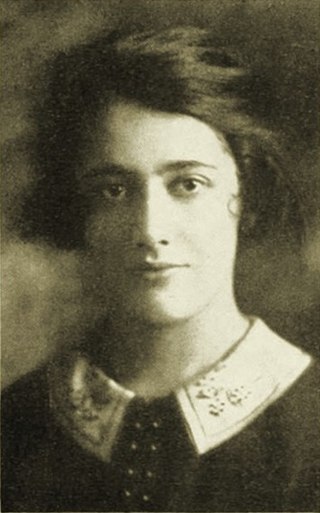
Gertrude Charlotte Moakley was an American librarian and a Tarot scholar. Moakley is notable for having written the earliest and most significant account of the iconography of Tarot, a card game which originated in the Italian Renaissance. She had worked at the New York Public Library.
Ronfa was a 15th-century Italian card game, probably of French origin, and one of the two earliest known games in Europe. It may also have been the name of a since lost game of dice or tables.



